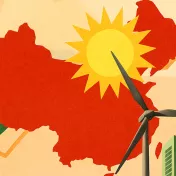India made the world news today, on October 2nd - Gandhi's brithday, a special day for India - by submitting its ratification of the Paris climate agreement to the United Nations. With India formally joining the agreement, it not only accepts its obligations under the agreement, but also brings the agreement one step further towards entry into force. Ratification by India signals a new, more active role, in international climate policy, building on progress achieved at the domestic level. The coming years will be crucial to confirm India's development path in a greener and more sustainable direction. Partnerships with countries like Germany will be essential to enable this transformation.
The Paris Agreement, adopted by the 196 Parties of the United Nations Convention on Climate Change (UNFCCC) on 12 December 2015 at COP21, currently undergoes the national ratification processes. The clause in Article 21 outlines that the Paris Agreement will enter into force once a minimum of 55 countries accounting for at least 55% of the global greenhouse gas (GHG) emissions have ratified the deal. The world's largest emitters, USA and China, jointly ratified the agreement in September 2016 at their meeting on the sidelines of the G20 Summit in Hangzhou, China. Their signatures brought more than 30% of the global emissions for the ratification process. Suddenly the entry into force of the Paris Agreement (30 days after the 55/55 rule is met) as early as this year became reachable. This would be much faster than most other multilateral agreements take between adoption at an international conference and entry into force. The current emission sum from 61 smaller and medium emitters who already have completed their national ratification processes reaches 48%.
The European Union (EU) could in one go push the world across the 55% emission finish line with its more than 12% global emission share, but this would require the Union itself as well as all of its 28 member states to ratify. It now seems like the EU will ratify and deposit its instrument of ratification alongside those individual member states that have already ratified without waiting for the slowest members. In that case, only the emissions from the members states that have already ratified would count towards the 55% threshold. . Individual member states like France and Germany have already finalized their national ratification processes but have not submitted the documents to the United Nations yet. India was indeed faster with submitting its instruments of ratification to the UN!
Prime Minister Modi to so on 2nd October 2016 - on Gandhi's birth anniversary, and exactly one year after India submitted its climate plan (Intended nationally determined contribution, INDC) to the UNFCCC.
The Paris Agreement ratification was discussed controversially in India. Some argued that an early ratification is risky for India since the implications of the new climate deal are still uncertain. These voices suggested waiting with the ratification until procedures and implications of an early entry into force became clearer. India had planned its INDC assuming the deal would become legally relevant from 2020 onwards. One of the concerns expressed was that climate change mitigation action could compete with tackling development challenges due to lacking support from the developed countries. This is a legitimate worry, but analysis by CANSA has proven that India's seemingly conflicting aims can be reconciled, and a fair global climate deal could actually be a catalyst supporting a more rapid move towards sustainable development in India.
Moreover, Government of India might also have kept geopolitical interests in mind. A permanent seat in the UN Security Council, a nuclear deal or improved US-India relations - could have been envisioned gains by withholding the ratification until concessions in these areas were reached.
Other stakeholders perceive the Paris Agreement as positive for India, considering the benefits of fewer climate change impacts, co-benefits of cooperative climate action for economic growth and geopolitical strength. In addition, it is very likely under the present scenario that the Paris Agreement will enter into force this year even without India signing in. If only a few more countries like France and Germany follow India and submit their ratification, the Paris Agreement will enter into force not even a year after its adoption. In this case, India would benefit of being part of the first negotiation round under the Paris Agreement, possibly taking place at COP22 in Marrakesh in November 2016. The early entry into force could also bring more clarity on the details of the Paris Agreement yet to be negotiated and its implementation. It will now be more urgent to clarify these points, like spelling out ‘Equity and Common But Differentiated Responsibility’ in more detail. Therefore, ratification was the right choice for India in order to be part of the negotiations.
India's domestic action
Ratification was also enabled by the fact that climate action on the ground in India has begun. The renewable energy targets in general and in particular the 100 GW solar energy target for 2022 that were perceived to be very ambitious are being put to practice and substantial gains are being made. Almost every week India introduces a new solar initiative - usually of large scale and impact.
Conclusions
Germany can support India's serious climate engagement by strengthening India's domestic action with enhanced bilateral cooperation. The existing bilateral agreements such as the Indo-German Solar Alliance, hold plenty of opportunity to let India leap-frog into low-carbon development. In particular, solar initiatives can build upon existing action, but to reach the 100 GW solar target by 2022 much additional capacity is to be installed. Germany can certainly assist India in mainstreaming solar energy through information, know-how and suitable technology.



